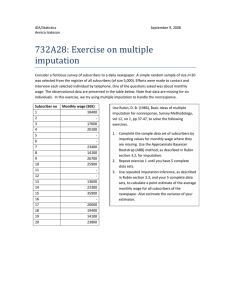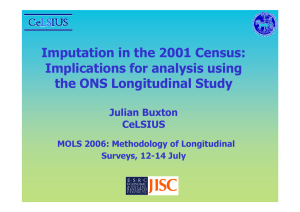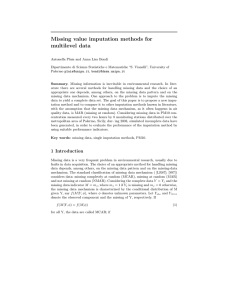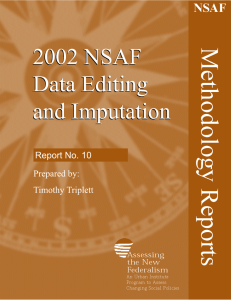Households and families John Haskey • Angela Antonatos • Oliver Duke-Williams
advertisement
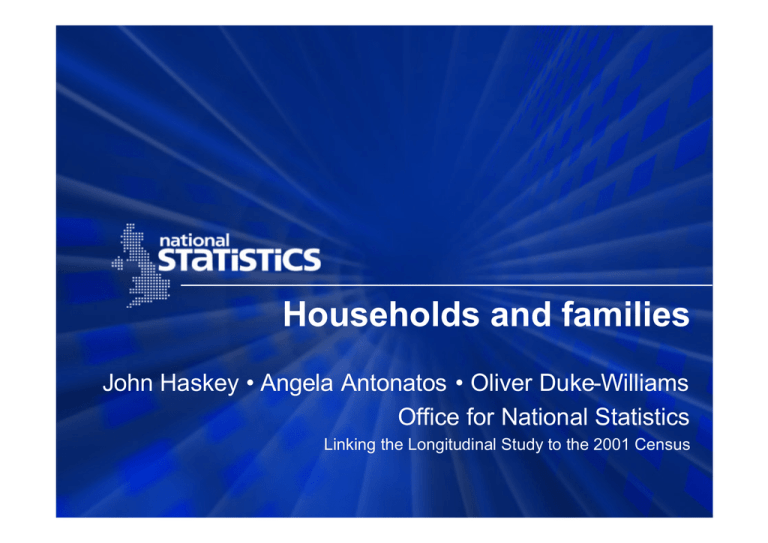
Households and families John Haskey • Angela Antonatos • Oliver Duke-Williams Office for National Statistics Linking the Longitudinal Study to the 2001 Census The relationship question Persons up to Person 5 reported all relationships Subsequent persons reported relationships to Person 1 and the two preceding persons The relationship matrix Person number 1 2 3 4 5 6 7 8 1 - 2 3 4 5 6 7 8 , , , , , , , , , , , , , X X X X X X X X X - - Person number - X X X X X X , , - X X , , - X , , - • Top corner is fully reported • Remainder is partially reported Basic relationship types in 2001 Census • Husband / wife • Smaller set recognised than in 1991 • Partner • Son / daughter • Step-child • Does not include aunt/uncle, niece/nephew, cousin or any “in-law” • Brother / sister • Parent • Step-parent • Grand-child • Grand-parent • ‘Other related’ Basic family types • Ungrouped individuals • Married couple • Cohabiting couple, opposite sex • Cohabiting couple, same sex (male) • Cohabiting couple, same sex (female) • Lone parent (male) • Lone parent (female) Hazards to accuracy - limits to interpretation (1) • When things went wrong, what probably happened? • What are the implications? - cannot answer these questions completely, but insight has been gained • easiest to consider the identified problem areas according to the stage they occurred in the whole process Hazards to accuracy - limits to interpretation (2) 1. Answering the relationship question on the census form • Accidentally recording the relationship the wrong way round e.g. putting “parent” rather than “child” • only one relationship was supposed to be recorded - even if two were possible • there was no provision for “in-law” relationships to be recognised - they were probably recorded as “other related” or “unrelated” • similarly, the relationships available did not include stepbrother/stepsister - they could have been recorded as either brother/sister or other related • if one person filled in all the relationships, the result could be different than if each or several household members answered their part. Hazards to accuracy - limits to interpretation (3) 2. Edit stage • only a relatively small number of relationships checked 3. Imputation stage • (details in second half of presentation) 4. Household Composition Algorithm • some sets of relationships between household members could not be handled by the HCA Imputation and the Relationship Matrix John Haskey • Angela Antonatos • Oliver Duke-Williams Office for National Statistics Linking the Longitudinal Study to the 2001 Census Types of Imputation Flags The imputation flag for relationships operates at four levels: •the relationship level (RELnnIMP) •the individual level (RELPIMP) •the family level (RELFIMP) •the household level (RELHIMP) Relationship Imputation Rates by Household Size Household size 2 3 4 5 6+ Total no. households 156473 104945 120403 56643 25492 % Imputed 2.9 18.1 13.8 18.7 37.2 Highest and Lowest Imputation Rates by Covariate at Household, Family and Person Level % Household Family Person Sex 11.6 m 10.6 m 8.5 m 10.8 f 9.8 8.1 f 17.4 (12) 16.7 (12) 14.4 (12) 3.1 0.3 3.1 Age (yrs) Ethnicity Marital status (93) f (93) (93) 42.4 Bangladeshi 38.9 Bangladeshi 30.1 Bangladeshi 9.5 White British 8.7 White British 7.0 White British 13.8 single 12.3 single 11.2 single 4.2 widowed 1.9 3.5 widowed widowed Highest and Lowest Imputation Rates by Covariate at Household, Family and Person Level % Household Family Person Religion 34.4 Pentecostal 38.8 Pentecostal 25.0 Protestant 2.1 2.1 1.0 Gov Office Region County District Humanist Humanist Humanist 16.1 London 14.1 London 12.3 London 8.7 7.8 6.4 SE & SW SE SE & SW 28.3 Tower Hamlets LB 25.2 Newham LB 21.2 Newham LB 3.9 City of London 2.0 City of London 3.6 Fareham Imputation Increases Unlikely Relationships • In data with no imputed values, there is 1 family where a male’s brother is married to his mother. • When we include imputed relationships, there are 21 such families. • Imputation also introduces odd relationships that were not present in unimputed data. Conclusions • For smaller households, the indications are that there were few problems. • Complex and larger households were much more likely to have high rates of imputation, which warrant extra caution. • Important to keep in mind the earlier remarks about the relationship options offered - and that respondents in the same situation could have answered in different ways. • Overall, the introduction of the relationship matrix has been a significant advance and has allowed far more detailed analyses of families and households.
